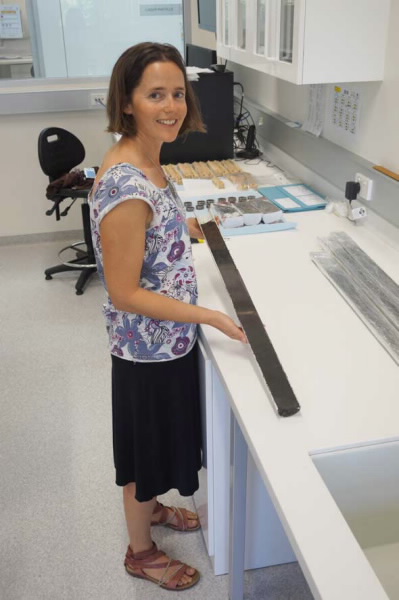The ITRAX micro X-ray Fluorescence (µXRF) core scanner which is housed in the Environmental Radioactivity Measurement Centre has now analysed more than a kilometre of cores since it became operational in 2012. The milestone is a reflection of the instrument’s capability to reconstruct past climate and environments.

“If you lined them up—core sample to core sample, they would reach more than a kilometre, said Senior Principal Research Scientist, Professor Henk Heijnis, the leader of Isotopes in Climate Change and Atmospheric Systems project (pictured above right).
The information obtained from the core scanner in combination with other techniques provides a multi-proxy approach to solving environmental puzzles. ANSTO and external researchers have utilised the ITRAX to image and identify elements in sediment cores, wood, coral, speleothems, feathers, clams, and whale baleen samples to answer important environmental questions.
ITRAX captures very high resolution optical images and X-ray radiographs; it uses X-ray fluorescence to profile elements, and obtains magnetic susceptibility (MS) profiles to identify ferromagnetic minerals that might be present in samples (excluding wood).
“It is a highly versatile technology, capable of scanning cores up to 1.8 metres long with a minimum resolution of 200 microns for XRF and generating X-radiographs at a finer resolution of 20 microns for thin samples like wood,” said Patricia Gadd, ITRAX Facility Officer (pictured above left).
“The resolution we get, five measurements in a single millimetre, is not actually physically possible using conventional XRF. That’s the beauty of it, the instrument is capable of producing a dataset in a few hours that would take weeks using conventional XRF,” said Gadd.
X-ray radiographs aid in distinguishing phases and artefacts that are present in the sample which guides researchers to sub-sample in appropriate areas for further analyses.
Gadd estimates the average processing time for a metre of sediment core at 1 mm resolution is approximately three hours. Although, analysing 70,000 year old stalagmites from cave deposits in Indonesia took far longer.
This was a bit out of the ordinary as the researcher who submitted the samples was looking for trace amounts of sulphur from volcanic eruptions. Speleothems are mostly calcium which makes locating other elements challenging.
“That was difficult. We had to analyse everything at the finest resolution and the longest time per step as possible. Basically, a stalagmite about half a metre long was set up for scanning on a Friday afternoon and the instrument ran all weekend. ”
The researcher was trying to find a link between a volcanic eruption 12,000 years ago and the disappearance of Homo floresiensis, an extinct species thought to be a human ancestor.
 Senior Research Scientist Krystyna Saunders (pictured above), who has utilised ITRAX technology to analyse lake cores from a sub-Antarctic Island to reconstruct past changes in the Southern Hemisphere’s westerly winds, states that the major advantage of the technique is that it is non-destructive.
Senior Research Scientist Krystyna Saunders (pictured above), who has utilised ITRAX technology to analyse lake cores from a sub-Antarctic Island to reconstruct past changes in the Southern Hemisphere’s westerly winds, states that the major advantage of the technique is that it is non-destructive.
It is a preferred technique to other approaches, such as conventional WD XRL (wavelength dispersive X-ray fluorescence), solution ICP OES (inductively coupled plasma atomic emission spectroscopy) and mass spectrometry as minimal sample preparation is required.
“Additionally the other techniques require very involved and time consuming sample preparation, said Saunders.
ITRAX is becoming increasingly valuable in atmospheric pollution studies. Researchers from the University of Melbourne submitted a core from Lake Owen Tarn in Tasmania. The lake lies close to the major mining centres in Queenstown within what is considered a pristine environment prior to the commencement of mining.
Looking at sediment cores from the lake, it is possible to see the impact of mining on the environment. The XRF elemental profiles display an elevation in levels of lead, copper and other elements concomitant with mining activities in that part of Tasmania.
“Subsequent to ITRAX analysis, inductively coupled plasma mass spectroscopy (ICP MS) can be used to quantify the elements to determine if they exceed the guidelines,” said Saunders.
A study carried out to reconstruct the environmental history of the Mill Creek catchment in southwestern Sydney is the subject of a chapter in Micro XRF Studies of Sediment Cores.
 |
| Optical image, X-radiograph, magnetic susceptibility, Mo Inc/Coh (as a measure of organic matter content), selected LOI (loss on ignition) results, and selected ITRAX-XRF results |
The ITRAX data revealed the presence of key anthropogenic metals, copper, lead, and zinc and an increase in sedimentation, which the authors attributed to an increase in urbanisation from the 1950s. Concentrations of metals were measured with conventional WD-XRF that indicated that some of the metals exceeded background levels.
The research was also able to confirm that a legacy waste site had not contributed any radioactive pollutants to the creek system.
As ITRAX has the capability of detecting ferromagnetic elements using MS, it can provide useful information about events that took place which caused these minerals to accumulate in the sediment. In the case of the Mill Creek catchment, increases in the magnetic susceptibility of iron, were explained by bushfires which increased erosion.
Many researchers have used ITRAX to study the historical impact of bushfires on the environment.
A collaboration led by a University of Melbourne researcher undertook a comprehensive study of fire that occurred in Tasmania during the mid-Holocene.
The ITRAX data obtained from sediment deposits from Lake Osborne revealed increases in iron that were associated with increases in the magnetic susceptibility following peaks in macroscopic charcoal content.
Our team has now analysed samples from almost every continent in attempting to assist with the reconstruction of ecosystems over the last 8000 years,” said Heijnis.
“The technology has untapped potential. We are experimenting with new applications all the time. Who knows what surprises the next kilometre of samples may bring!” said Heijnis.


